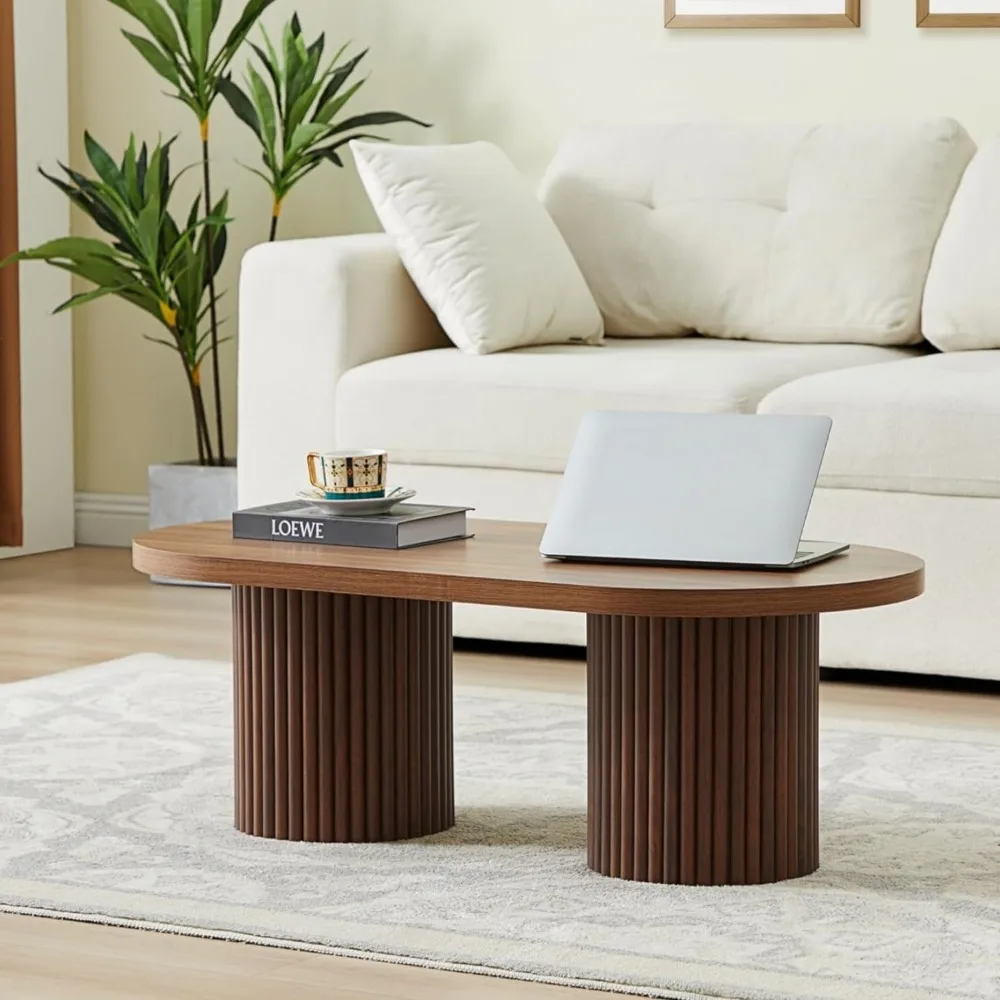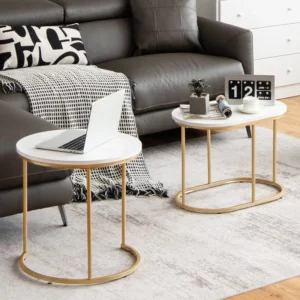Unlocking Seamless Movement: The Flow Benefits of Oval Coffee Tables
When you walk into a well-designed living room, you might not immediately notice why it feels so inviting and easy to navigate. Often, the secret lies in the furniture selection—particularly the coffee table at the center of it all. Oval coffee tables create natural movement patterns that simply work better with how we interact with our spaces.
Unlike their angular counterparts, oval coffee tables guide the flow of foot traffic around a room with their smooth, continuous curves. This isn’t just about aesthetics—it’s about practical functionality. When people move through a space, they naturally follow curved paths rather than making sharp 90-degree turns. An oval coffee table works with this natural tendency, allowing for more intuitive navigation.
The visual impact of curved edges extends beyond physical movement. Our brains process curved shapes differently than angular ones, perceiving them as more approachable and relaxing. This creates not just a physical sense of flow but a visual one that makes the entire room feel more harmonious. Recent oval coffee table trends have embraced this principle, with designers increasingly recognizing the importance of shape in creating comfortable living spaces.
Interior designers often point to principles similar to those used in urban planning—curved pathways feel more natural and create less resistance than grid systems. In home interiors, this translates to easier movement and a subtle psychological comfort that straight-edged furniture simply can’t provide.
The fundamental design features of oval-shaped tables create this sense of flow by eliminating the visual stopping points that corners create, allowing both the eye and body to move continuously through the space. This foundation of improved movement sets the stage for numerous practical benefits in everyday living.
Say Goodbye to Sharp Corners: Safety and Smooth Movement
One of the most immediate benefits of oval coffee tables is the elimination of sharp corners—a feature particularly valued by families with young children, homes with elderly residents, or households with pets. The safety advantage is clear: without pointed corners at shin or head height, the risk of painful impacts and injuries decreases significantly.
The safety benefits extend beyond just preventing bruises:
- Reduced injury risk from falls or collisions
- Less likelihood of clothing snagging on corners
- Lower risk of damage to other furniture pieces during rearrangement
- Decreased chance of serious injuries to toddlers learning to walk
Research consistently shows that furniture-related injuries in the home often involve impact with sharp corners, making the switch to curved furniture a practical safety decision rather than just an aesthetic one.
Beyond safety, the smooth edges of mid-century modern oval coffee tables allow for more natural human movement. People instinctively move around curved objects with greater ease, maintaining their natural walking rhythm rather than making awkward adjustments to navigate around corners. This creates a subconscious sense of comfort and ease when moving through a room.
The psychological impact shouldn’t be underestimated either. Angular furniture with sharp corners can create subtle tension—our brains remain slightly alert to potential hazards. Curved edges remove this tension, contributing to a more relaxed environment overall.
Creating Natural Pathways: Enhancing Traffic Patterns
Consider how people typically move through a living room: from entrance to sofa, from sofa to entertainment center, between seating areas, and to adjacent rooms. Oval coffee tables naturally accommodate these movement patterns by creating multiple possible pathways around their curved perimeters.
When rectangular tables are placed in living spaces, they often create rigid, limited pathways. People must choose to go around the long or short side, sometimes leading to awkward navigation or bottlenecks when multiple people are moving through the space. Oval tables, by contrast, allow for more gradual, intuitive path choices that adapt to the natural flow of movement.
This flexibility in traffic patterns becomes especially valuable in open-concept living spaces where the coffee table might serve as a divider between functional zones. The curved outline guides movement between these areas without creating harsh visual or physical boundaries.
In smaller spaces, oval tables excel at reducing bottlenecks. Rather than forcing a narrow passage along one side, their tapered ends create wider passing zones at the points where people most commonly navigate around them, particularly when placed between a sofa and TV or between opposing seating arrangements.
The Gentle Guide: Visual Softness and Inviting Aesthetics
Beyond the practical movement benefits, oval coffee tables contribute significantly to the visual flow of a room. Their organic shape introduces a pleasing visual rhythm, especially in spaces dominated by straight lines from walls, rectangular sofas, and entertainment units.
Interior designers regularly employ curved elements to create visual interest and break up the monotony of straight lines. An oval coffee table serves this purpose perfectly, becoming a central design element that softens the overall feel of the space. The eye naturally follows curved lines, creating a sense of movement even when viewing the room from a stationary position.
This visual softness aligns with biophilic design principles—our inherent connection to natural forms. Straight lines are rare in nature, while curves and organic shapes are abundant. Oval coffee tables in minimalist interiors create this important connection to natural forms, even in the most contemporary spaces.
The psychological impact of curved furniture extends to social dynamics as well. Research suggests that people perceive environments with curved furniture as more inviting and conducive to conversation. The oval shape symbolically brings people together, encouraging interaction rather than creating barriers.
Maximizing Your Layout: The Space-Optimizing Power of Oval Coffee Tables
While flow benefits might be the most immediately noticeable advantage of oval coffee tables, their space optimization capabilities are equally impressive. In the world of interior design, how space is perceived can be just as important as actual square footage.
Oval coffee tables excel at creating this balance between actual and perceived space. They provide generous surface area for practical use while visually consuming less space than their rectangular counterparts. This optical advantage comes from their tapered ends and continuous curve, which allows light and sightlines to flow around them more easily.
The distinction between actual and perceived space is crucial in interior design. A room can be physically spacious yet feel cramped due to poor furniture choices, or conversely, a smaller room can feel more expansive with the right pieces. Oval coffee tables contribute to the latter effect through their visual lightness and efficient use of space.
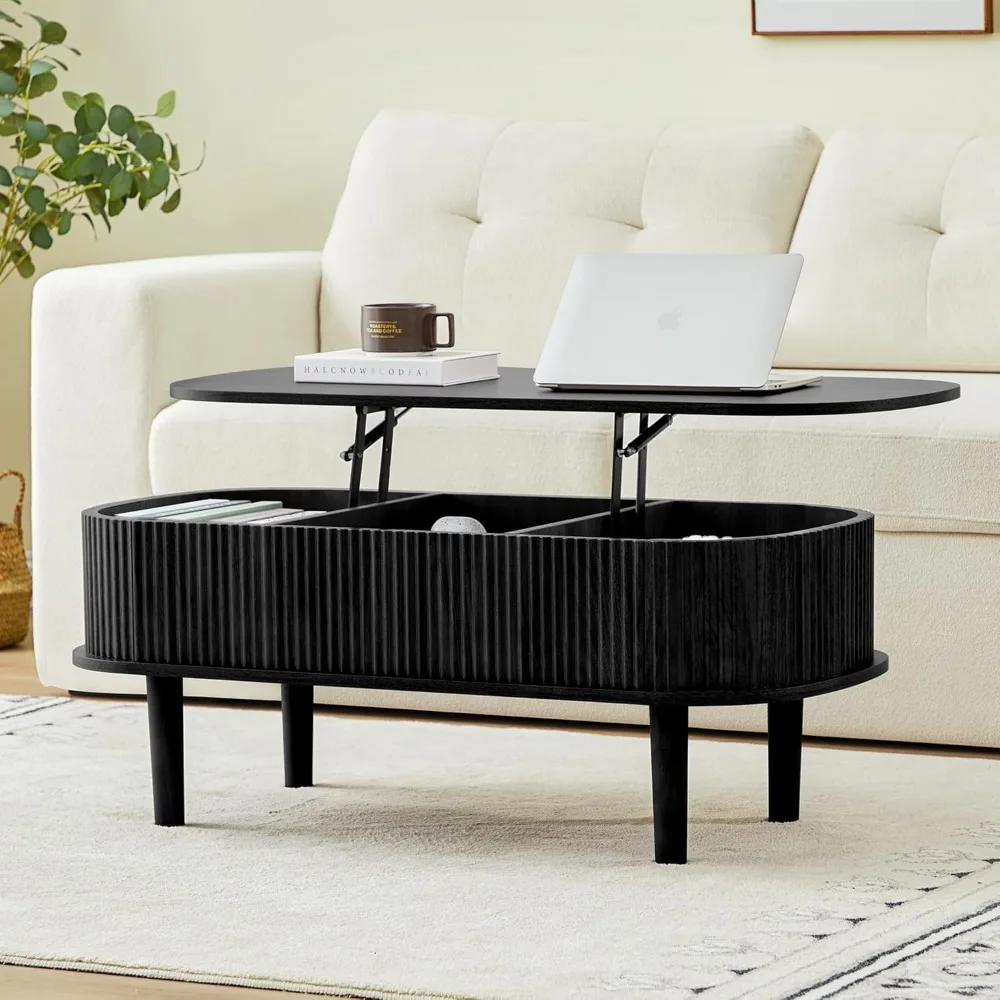
This space-optimization effect becomes particularly valuable in apartments, condominiums, or smaller living areas where every square foot matters. Designers often recommend curved furniture in these contexts precisely because they need furnishings that serve their functional purpose without overwhelming the available space. The principles behind space-saving coffee tables that maximize living areas apply perfectly to the oval shape.
The Illusion of Expanse: Achieving Perceived Openness
Oval coffee tables create an impression of openness through several visual mechanisms:
- Their lack of sharp corners reduces visual stopping points
- Their narrower profile at the ends allows more floor to be visible
- Light passes around their curved edges more fluidly
- Their organic shape creates less visual mass than geometric alternatives
This perceived openness comes from how our eyes process shapes. Angular furniture presents definitive boundaries and clear visual weight. Curved pieces like oval tables create softer boundaries that the eye moves past more easily, resulting in less visual interruption.
The effect is particularly pronounced with glass-top coffee tables where transparency further reduces visual weight. However, even solid oval tables in darker materials maintain this advantage over their rectangular counterparts due to their fundamental shape.
For rooms that feel slightly cramped or confined, this visual expansion can transform the entire feeling of the space without requiring structural changes or expensive renovations. It’s a strategic design choice that addresses perception rather than changing actual dimensions.
Smart Surface, Efficient Footprint: Getting the Most from Your Floor Space
Mathematically speaking, oval coffee tables offer an impressive ratio of usable surface area to floor footprint. While a rectangular table creates unused or awkward corner spaces, the continuous curve of an oval maximizes usable surface while minimizing the total area occupied.
This efficiency becomes apparent when considering how items are typically placed on coffee tables. Books, remotes, decorative objects, and beverages are rarely placed in the far corners of rectangular tables. The oval shape eliminates these underutilized corner spaces while preserving the functional central area where items are most commonly placed.
For anyone wondering about the best shape coffee table for a small space, this surface-to-footprint efficiency makes oval tables a compelling option. They provide the necessary functional surface without demanding excessive floor space—an ideal compromise for smaller rooms.
The continuous edge of oval tables also facilitates easier access from all sides. Unlike rectangular tables where reaching items placed in far corners can be awkward, the gradual curve of an oval allows more comfortable access to all areas of the surface from various seating positions.
Adaptable by Design: Versatile Placement Options
Perhaps one of the most practical advantages of oval coffee tables is their versatility in different room configurations. Their shape naturally accommodates various furniture arrangements that would be challenging with rectangular or square options.
This adaptability shines in asymmetrical rooms or when working with non-standard furniture arrangements. The oval shape can bridge different seating groups, complement curved sectionals, or work well with angled furniture placements that would create awkward gaps with rectangular tables.
The relationship between oval tables and sectional sofas deserves special mention. The curved ends of an oval table naturally complement the angle or curve of L-shaped sectionals, creating a harmonious flow between the pieces. Similarly, nesting coffee tables with oval shapes offer additional flexibility for changing needs.
For rooms that serve multiple functions or homes where furniture arrangements change seasonally, this adaptability provides ongoing value beyond aesthetics. The oval table simply works in more scenarios than its more rigid counterparts.
Oval vs. The Rest: A Shape Showdown for Flow and Space
To fully appreciate the advantages of oval coffee tables, it helps to understand how they compare to other common shapes. Each table shape has its strengths and ideal applications, but when optimizing for flow and space, the distinctions become particularly relevant.
Coffee tables typically come in four primary shapes: rectangular, square, round, and oval. Each creates a different relationship with the surrounding space and furniture. Rectangular tables remain the most common, largely due to tradition rather than optimal functionality. Square tables often work well in perfectly balanced room arrangements but can create flow problems similar to rectangles.
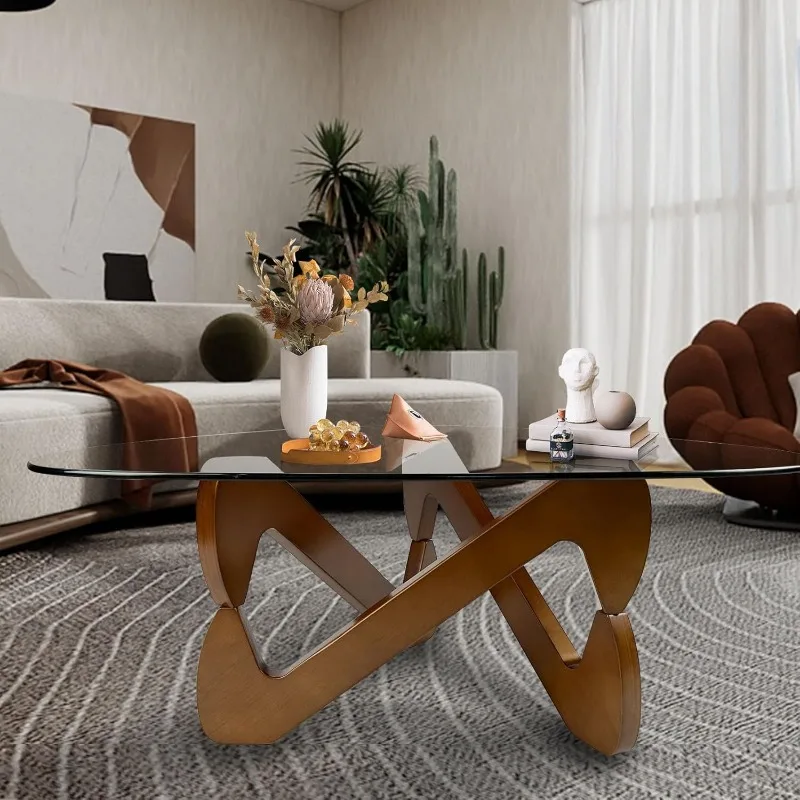
When evaluating coffee table shapes, several criteria matter: how they guide movement, their visual impact on perceived space, their efficiency in surface area usage, and how they complement surrounding furniture. Understanding the distinct differences between oval and rectangular coffee tables helps clarify these considerations.
Oval vs. Rectangular/Square Tables
The comparison between oval and rectangular tables reveals several key differences:
In terms of movement flow, oval tables eliminate the four corner obstacles that rectangular tables present. This reduces the “pinch points” where people must navigate around sharp corners, especially in tight spaces between the table and surrounding furniture.
Surface area efficiency differs significantly as well. While rectangular tables might offer slightly more total surface area for equivalent outer dimensions, oval tables eliminate the rarely-used corner spaces while preserving the functional central area. The oval shape also allows more people to gather around comfortably without anyone being relegated to an awkward corner position.
Perhaps most notably, oval tables create substantially less visual weight. A rectangular table clearly defines its boundaries with straight edges and sharp corners, creating a heavier visual presence. Oval tables soften this boundary, allowing the eye to move past them more easily and creating the impression of more space.
When deciding between shapes for sectional sofas, many homeowners debate whether a round or square coffee table works better with a sectional. Oval offers a compelling middle ground, providing the corner-free advantages of round tables while maintaining directional orientation that complements the sectional’s form.
Oval vs. Round Tables
The comparison between oval and round tables presents more subtle distinctions, as both share the advantage of eliminated corners.
In flow benefits, both shapes perform similarly well, guiding movement smoothly without corner obstacles. However, oval tables provide directional guidance that round tables lack. This directional quality helps define the orientation of a seating area—particularly valuable in open-concept spaces where furniture arrangement creates virtual “rooms.”
For surface area efficiency, oval tables generally provide more usable space than round tables of comparable width. This makes them particularly valuable when placed between opposing sofas or in narrower rooms where a wide round table would impede movement paths.
Round tables excel in perfectly square rooms or central seating arrangements where furniture surrounds them equally on all sides. Oval tables perform better in rectangular rooms or with more linear furniture arrangements like the traditional sofa-and-chairs configuration.
The choice often comes down to the specific room proportions and furniture arrangement. Round tables create perfect symmetry, while oval tables provide gentle direction to the space.
When Does an Oval Coffee Table Shine? Ideal Scenarios and Use Cases
While oval coffee tables offer numerous advantages, certain situations particularly highlight their benefits:
- Narrow living rooms where traffic must flow around the long sides of the seating area
- Rooms with L-shaped sectional sofas where the table needs to bridge different seating zones
- Open-concept spaces where the coffee table helps define a living area without harsh boundaries
- Homes with young children or elderly residents where safety concerns are paramount
- Small apartments where both actual and perceived space optimization matters
- Rooms with mixed angular furniture that benefit from the softening effect of curves
The oval shape particularly excels in rectangular rooms with standard sofa-and-chairs arrangements. The oval’s longer dimension naturally aligns with the sofa’s length, while its narrower width maintains appropriate distance to chairs on the sides.
For homes with open floor plans, oval coffee tables help create subtle boundaries between functional zones without the harsh delineation that rectangular furniture can create. Their curved form guides movement between spaces while maintaining visual connection.
Mid-Century Modern Solid Wood Coffee Tables, Mid-Century Modern Teak Coffee Tables
$879.95 Select options This product has multiple variants. The options may be chosen on the product pageMid-Century Modern Danish Coffee Tables, Mid-Century Modern Oval Coffee Tables, Mid-Century Modern Solid Wood Coffee Tables
$390.05 Select options This product has multiple variants. The options may be chosen on the product pageMid-Century Modern Coffee & End Table Sets, Mid-Century Modern Coffee Table Sets, Mid-Century Modern Oval Coffee Tables
Price range: $257.48 through $331.04 Select options This product has multiple variants. The options may be chosen on the product pageMid-Century Modern Glass Top Coffee Tables, Mid-Century Modern Glass Top Side & End Tables
$460.58 Select options This product has multiple variants. The options may be chosen on the product pageMid-Century Modern Glass Top Coffee Tables, Mid-Century Modern Vintage Coffee Tables, Mid-Century Modern Vintage Side & End Tables
$725.36 Select options This product has multiple variants. The options may be chosen on the product pageMid-Century Modern Nesting Coffee Tables, Mid-Century Modern Nesting Table Sets
$361.45 Select options This product has multiple variants. The options may be chosen on the product page
Families with pets or young children often find oval tables reduce household accidents significantly. The safety benefit becomes even more valuable in homes where elderly individuals might have mobility concerns or balance issues that make sharp corners particularly hazardous.
Styling Your Oval Coffee Table for Optimal Flow and Space
Selecting an oval coffee table is just the first step—proper styling and placement maximize its flow and space benefits. The goal is to enhance functionality while maintaining the visual lightness that makes oval tables so effective.
When styling an oval coffee table, balance is key. The curved shape naturally invites a more organic, asymmetrical arrangement of items rather than rigid, grid-like placement. This complements the table’s flowing nature while maintaining its functional purpose.
Effective styling maintains clear pathways across portions of the table surface. Unlike rectangular tables where items are often pushed to the perimeter, oval tables benefit from a more centralized arrangement with clear areas at the tapered ends where people most frequently pass items across the table.
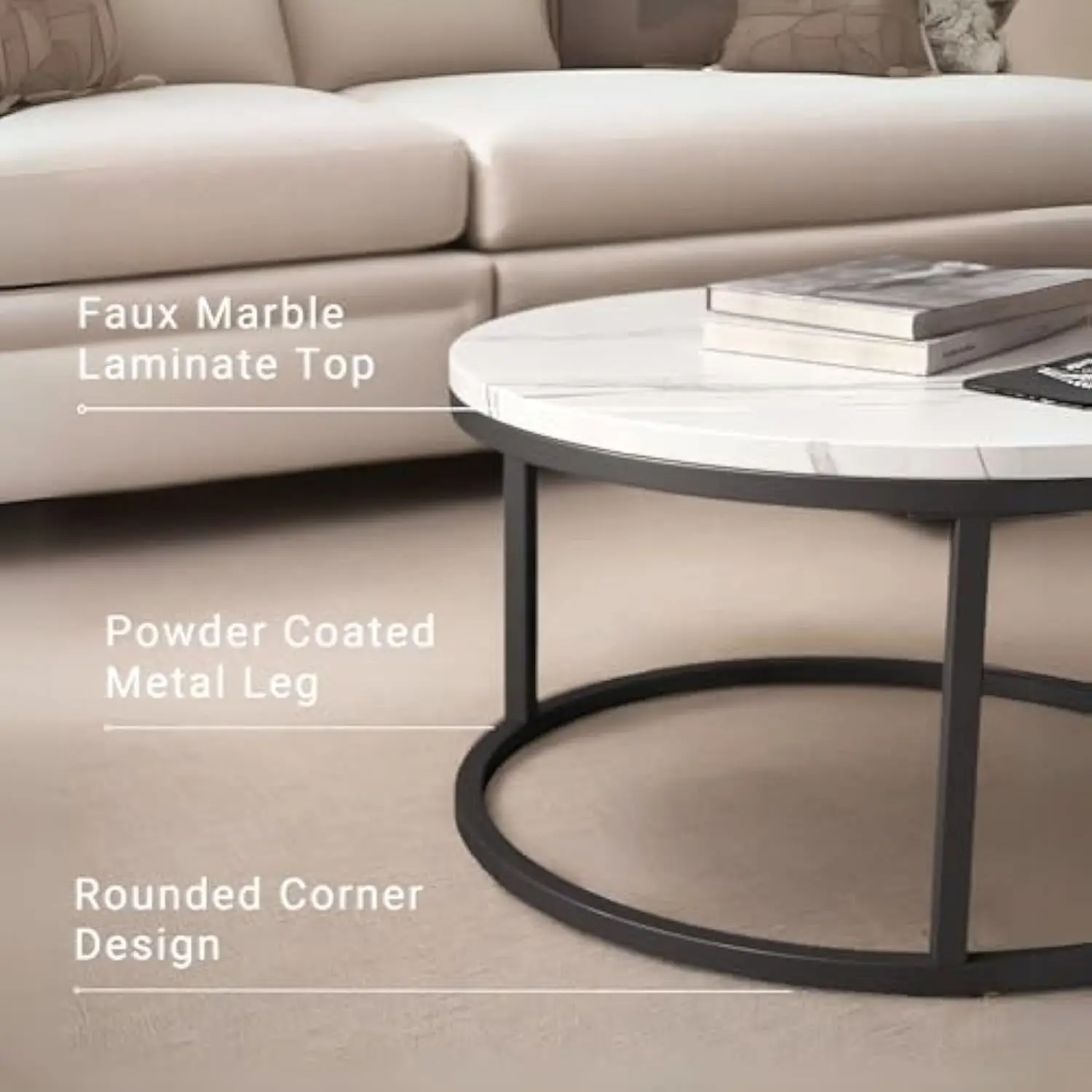
For more detailed guidance, exploring how to perfectly style an oval coffee table can provide inspiration specific to your decor style and functional needs.
Finding the Right Proportions: Size and Scale
Proper proportions ensure your oval coffee table enhances rather than disrupts room flow:
- Length: Ideally about two-thirds the length of your sofa
- Width: Typically between 22-30 inches depending on surrounding space
- Height: Generally 1-2 inches lower than surrounding seating (typically 16-18 inches)
- Clearance: Maintain 14-18 inches between table and seating, and 24-30 inches for walkways
These proportions ensure the table is substantial enough to be functional without overwhelming the space. The height relationship to seating is particularly important—too high disrupts sightlines and comfort, too low makes reaching items awkward.
Hearth Forms offers solid wood coffee tables in various proportions to match different room sizes and seating arrangements. When selecting, consider both the table’s dimensions and how its visual weight works with your existing furniture.
For smaller spaces, consider an oval table with a narrower width to preserve walking paths while maintaining usable surface area. Larger rooms can accommodate wider oval tables that provide more substantial surface area while still maintaining the flow benefits.
Strategic Positioning: Placement Pointers
Proper placement amplifies the flow benefits of oval coffee tables:
- Center the table’s length with the main sofa
- Allow slightly more space at the ends where traffic typically flows
- Consider angling the table slightly when used with sectionals to follow the seating line
- In conversation areas with chairs on multiple sides, position the table to facilitate easy reach from all seats
The oval shape allows for more flexibility in exact positioning than rectangular tables. You can adjust the angle slightly to better complement surrounding furniture or to guide traffic in a specific direction.
For mid-century modern enthusiasts, understanding the principles of mastering mid-century oval coffee table placement can help achieve that authentic, intentional look while maximizing functionality.
In open-concept spaces, use the oval table’s orientation to subtly define the living area’s direction and focus. This helps create zones without visible boundaries, maintaining the openness of the space.
Material and Leg Design Matters
The material and base design of an oval coffee table significantly impact its effect on room flow and perceived space:
- Glass tops increase the perception of space through transparency
- Light wood tones create less visual weight than darker finishes
- Metal bases with open designs allow light to pass underneath, enhancing spaciousness
- Solid bases provide stability but create more visual weight
Consider how different materials affect not just aesthetics but functionality in your specific space:
- Glass tops reflect light and create a sense of openness but show fingerprints and require more frequent cleaning
- Wood provides warmth and durability but creates more visual substance
- Composite materials offer versatility in design but may lack the character of natural materials
- Metal elements can add visual interest while maintaining a light appearance
In high-traffic areas, consider how the base design affects floor cleaning. Pedestal or X-bases often allow easier vacuuming than four-leg designs, a practical consideration for maintaining flow in everyday living.
Beyond Flow and Space: Other Noteworthy Advantages
While flow and space optimization are the primary benefits of oval coffee tables, several additional advantages make them worth considering:
Oval tables naturally facilitate better social interaction. Their shape eliminates the hierarchy that can occur at rectangular tables where people at the ends might feel separate from those along the sides. The continuous curve creates a more democratic gathering space where everyone feels equally included in conversation.
Their versatility across design styles is remarkable as well. Oval tables complement traditional interiors with their classical proportions, suit mid-century modern spaces with their organic yet geometric form, and work in contemporary settings where their sculptural quality adds interest.
From a practical perspective, oval coffee tables often provide better functionality for common activities. The continuous edge makes passing items easier, and the absence of corners means remote controls and other small items are less likely to get pushed into hard-to-reach spots.
For multi-functional spaces like apartments where the living room might occasionally serve as an entertaining space, oval tables adapt more easily to different arrangements and purposes than their more rigid rectangular counterparts.
Is an Oval Coffee Table the Right Choice for You?
When considering an oval coffee table, ask yourself:
- Does your room have narrow pathways or tight spaces where flow is currently restricted?
- Do you have young children or pets that make safety a priority?
- Does your existing furniture feature predominantly straight lines that could benefit from the contrast of curves?
- Do you need to maximize both actual and perceived space?
- Is your seating arrangement linear (traditional sofa setup) or more circular (conversation area)?
While oval coffee tables offer numerous benefits, they may not be ideal for every situation. Very small square rooms might be better served by round tables, while very large, open spaces with substantial seating might require the greater surface area of rectangular options.
Consider your primary use case as well. If your coffee table frequently serves as a dining surface or workspace, the geometry of rectangular tables might better accommodate those functions. If it’s primarily for decorative purposes and occasional use, the aesthetic and flow advantages of oval might take precedence.
Ultimately, the right coffee table balances practical needs with aesthetic goals and enhances rather than hinders your daily living experience. For many homes, an oval coffee table proves to be that perfect balance.

